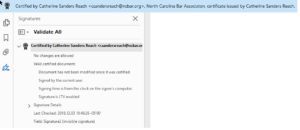How To *Really* Lock Down a PDF Document
Did you know that it is very easy to edit a PDF document unless you take steps to secure it? You can convert a PDF to Word in MS Word 2016 or in Adobe Acrobat and other PDF conversion applications. You can also easily edit a PDF in Acrobat. If you want to secure a PDF there are many ways to do so, but the strongest security is to apply a watermark, disable copying and printing, and apply a digital signature. This three-step process will create a document that is very difficult to alter or reproduce.
To create a PDF document that would be difficult to tamper with, including reproducing from a screenshot, you can take a three-step approach:
1.) The first step is to apply a watermark. To add a watermark type “Watermark” into the Search Tools box and choose “Add Watermark”. There are many options to choose from and you can add any text you like, for instance “Do Not Alter” or “Final.”
2.) Next add password protection. You can apply password protection that requires a password to open the document, but you can also apply protection that includes disabling printing, editing or copying of the document. This is a good security method, though Acrobat warns that other PDF readers and conversion tools may not respect the restrictions. And just like all passwords, the password needs to be long and strong and unique.
3.) An additional, even more stringent security can be applied in Adobe Acrobat DC Pro (and previous versions of Acrobat) by creating a digital signature. A digital signature will let you lock down a PDF document with a trusted digital ID that encrypts the document, identifies you as the document owner with a unique identifier, and adds a visible proof of authentication via a blue bar that appears across the top of the document.
You can get a digital signature certificate based ID accredited by a certification authority or an Adobe Approved Trust Service Provider such as Intesi Group or Dtrust, or use a file based Digital ID stored on your local device or stored as a Windows certificate. If the intent is simply to add protection to a PDF beyond a password then a file based ID will suffice. The process of adding a certificate based signature will also protect the file from being altered.
The easiest, most expedient way to add an invisible digital signature in Adobe Acrobat DC Pro is to type “Certify” into the “Search Tools” box in the right column. Choose “Certify (Invisible Signature).” A pop-up will appear instructing you to get a third party certificate. While you can certainly do that, if you continue you can create a Digital ID or Windows Digital ID that will suffice for the purposes of securing a document from tampering. Click “Configure New Digital ID” and then “Create a new Digital ID.” Then choose “Save to File.” Click “Continue” and follow the prompts to create a Self-Signed Digital ID. Choose “Digital Signatures and Data Encryption” from the drop down menu for “Use Digital ID for.” You will be prompted to create a password. A self signed certificate will be stored on the machine you create it on so this Digital ID will only be available on the computer you are using to create the ID.
Once you create the ID then you can continue and apply it. You will be given some options on the type of permissions a recipient may have, including form filling and annotation. Apply the permissions as necessary then finish signing. Consider saving this watermarked, copy protected, digitally signed copy as a version, adding “_certified” to the file name to make it easy to distinguish and identify that this is the certified copy.
There is no perfect security and a very motivated person could simply view the document on a screen and retype it. However, by adding watermarks and digital signatures you will know that anything else is a forgery. If you would like to see a tutorial video on how to accomplish these steps, as well as how to secure MS Word documents, see “How to… Not Pull a Manafort” from the Chicago Bar Association’s How To… video library.
Catherine Sanders Reach is the Director of the North Carolina Center for Practice Management. NCBA members, click here to learn more about how the Center for Practice Management can help you. NCBA CPM: Practice Smart.
